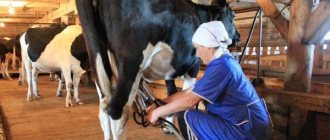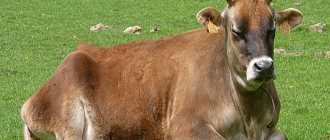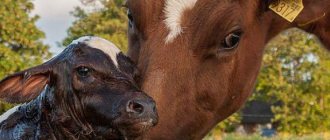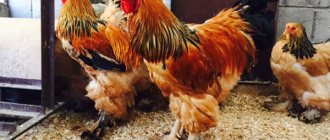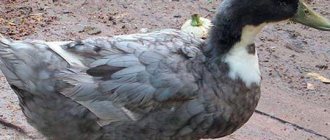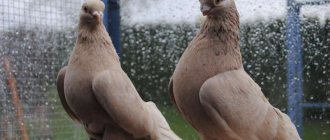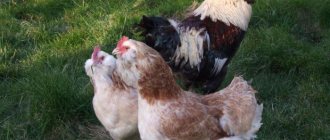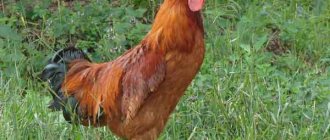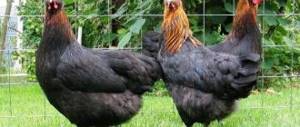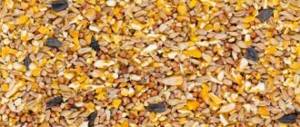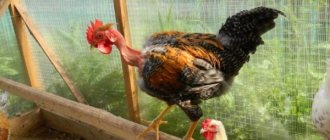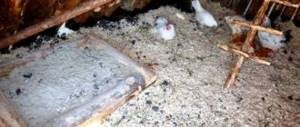The Hereford breed of cows is famous for its high meat yield, aromatic and delicate taste. Although such cows cannot be milked, since all the milk is used to feed the calf, farmers still recommend breeding these cows for their meat. In addition, Herefords are able to walk long distances, are not fussy about care and maintenance, and eat any grass.
Contents of Herefords
Contents of Herefords
The Hereford breed tolerates conditions of different climatic zones well, and inherited endurance for long hauls from the original draft breeds, taken as the basis for breeding work. Even in unfavorable conditions and with a meager diet, they are capable of gaining weight. This is one of the best breeds for grazing; the animals are not picky and eat even coarse and weedy vegetation. Conflicts in the herd rarely occur; representatives of this breed are calm, peaceful and flexible.
The Hereford breed is well suited for grazing
Herefords are very responsive, quickly responding to changes in living conditions and feed composition. With good feeding, it is possible to achieve weight gain of up to 1.5 kg per day. As autumn approaches, animals fatten up in preparation for the onset of cold weather. Subcutaneous fat is gradually consumed over the winter. With the onset of autumn, Hereford cattle grow thick and rather long hair. Cows shed in the spring.
By winter, Hereford cows grow quite long hair.
The best way to keep Hereford cattle is natural pasture. This ensures an optimal balance between animal performance, meat quality and production costs. The main disadvantage of grazing livestock is the limited possibilities of application in some regions of Russia due to their climatic and environmental characteristics.
The best way to keep Herefords is pasture
Possible solutions to the problem include:
- creation of artificial pastures using special mixtures of perennial grasses;
- sowing valuable annual forage plants;
- feeding with concentrated feed;
- use of pastures in the autumn-winter period.
Herefords are non-conflicting, but to reduce the likelihood of hierarchical disputes in the herd and associated stress, it is recommended to form groups of animals of the same age. Calves are usually kept with cows until the end of the suckling period. With suckling rearing of young animals, the best rates of weight gain are achieved.
During the suckling period, calves are usually kept with cows
In Russian conditions, the combined method of keeping is most widespread. In summer, animals are fed on the green mass of natural and cultivated pastures; the winter diet consists of silage, hay and concentrated feed. Due to summer feeding, it is possible to reduce the cost of meat production by almost half. When animals move freely, metabolism improves, intensive muscle mass builds up without excess fat, and good weight gain is achieved. Active exercise promotes the proper formation of the skeleton and strengthens the immunity of animals.
Feeding Hereford cows
Hereford cattle are cold-resistant. With proper feeding, cows tolerate frosts down to -30 degrees and can winter under a canopy. On meager feed, the rate of weight gain decreases from 1 to 0.5 kg per day; animals suffer greatly even with relatively minor cold snaps.
When properly fed, Herefords are resistant even to severe frosts
Herefords are resistant to diseases; with good care and feeding, they practically do not get sick even when kept outdoors. In regions with harsh winters, cows are kept indoors during the cold season
For successful wintering, it is important that the room is dry, clean and free of drafts. Otherwise, especially with a poor diet, the cattle will get sick
Each animal is given a den, which must be kept clean. The animals themselves will also need cleaning; contaminated, matted fur does not retain heat well. When working on a farm, sudden movements and sounds that can frighten livestock are extremely undesirable. The optimal solution for Hereford cows is free-stall housing on deep, permanent bedding.
Loose housing indoors
Free-stall housing is the most physiological; the possibility of free movement of animals within the barn helps maintain muscle mass.
Hereford cow breed - characteristics
Under natural conditions, Hereford cows are among the best for keeping and fattening. They are able to build up a large amount of muscle mass, making the animals ideal for industrial breeding and private farming.
The Hereford breed of cows is quite unique and has very positive characteristics:
- Animals are excellent producers.
- They grow and gain weight very quickly.
- They have a calm and flexible character.
- Unpretentious in food.
- They produce high quality meat.
- They can perfectly adapt to living conditions and weather.
Description of the breed
Hereford cows are distinguished by their large build, stocky body structure and great endurance, which helps them move long distances in search of good pastures. The color of the suit is dark red, and the head, dewlap, belly and tail tuft are white. Representatives of this breed are distinguished by the following external characteristics:
- Height at the withers is about 120–130 cm.
- Chest depth - 30–65 cm.
- Body length is about 152 cm.
- Chest girth is 195–197 cm for cows, 210–215 cm for bulls.
- Strong and muscular body, rectangular in shape.
- Thin and elastic skin covered with soft hair.
- Wide-set and short legs.
- Thick neck, small in size.
- Round chest with a pronounced dewlap.
- The mammary glands are poorly expressed.
- Color: red-brown.
- The withers, horns, head, nose and lips, belly, tassel on the tail are white.
Productivity characteristics
Today, the Hereford breed of cows is the most common beef cattle in the world. This is explained by the fact that caring for them does not require much effort and time, these animals grow quickly, live long and are very unpretentious in food. In addition, cows produce excellent offspring. The productivity of Hereford animals can be characterized as follows:
- Milk. Herefords are a type of beef cattle that are raised to produce high-quality meat, so the cows are not milked. In addition, the milking process can be dangerous, since the animals are quite timid and can kick with their hoofs. A year from one cow you can get 1000–1200 kg of milk with a fat content of 4%.
- Body mass. The weight of newly born calves is 25–35 kg. They grow very quickly and after two months they can already weigh 100 kg. In a year, bull calves already weigh 350–500 kg. A three-year-old cow weighs 600–700 kg, and a bull about 1000–1500 kg. Product yield at slaughter is 65–70%. The meat of the Hereford breed is of very high quality, it is called “marbled” - tasty and tender with thin layers of fat.
- Reproduction. Herefords are early maturing breeds that produce healthy offspring every year. A cow has her first calf when she is 2 or 3 years old. Then healthy babies appear annually. Hereford cows have good maternal instincts and feed their calf milk until it is 8–10 months old.
- Using the skin. The animals have thick, flexible skin of good quality, which is used in the shoe industry, as well as for making bags, wallets and other accessories.
general description
The breed was bred by English farmers at the end of the 18th century. Named after the county of Herefordshire
The breed is believed to have originated from the red-colored and short-sized Roman Briton cattle. Calves born to Hereford bulls almost always have a distinctive white head, and many farmers believe this type of identification is a selling point.
They quickly gained popularity in the international market. They entered the territory of the Soviet Union in the late 20s of the twentieth century. Excellent characteristics made this breed popular and they began to use it in breeding experiments, as a result of which a new type of cattle was developed - the Kazakh white-headed.
Thanks to their strong constitution, the herd can easily withstand any climatic conditions - the animals are not afraid of either heat or cold. They are bred not only abroad (on farms in America and Australia), but also in our countries (Russia, Belarus, Kazakhstan).
They differ in their physical characteristics. Adult animals grow to a height of 130-150 cm. In girth, bulls reach 215-220 cm, and heifers - 195 cm. The animal's body in shape resembles an elongated barrel, moreover, it is wide with an expressively protruding sternum. The coat is thick and slightly curled at the ends.
Appearance
Herefords have a pronounced meaty build and large dimensions. The height of the cow at the withers is 124-150 cm. The oblique length of the body can reach 158 cm. The color of this breed line is exclusively red (in various shades). In this case, the head, sternum and abdominal part are highlighted in white.
As for the characteristic features of the constitution of the Hereford cow, they include:
- deep chest (up to 70 cm) with large coverage;
- rectangular massive body with a flat back;
- pronounced muscle mass with a minimal layer of fat;
- the neck is small, thick;
- horns are poorly developed;
- the head is quite small in comparison with the body;
- limbs widely spaced;
- the udder is poorly developed;
- the skin is thin, elastic, elastic.
Advantages of the Hereford breed
It adapts to cold, heat, and harsh climates. Animals in a herd easily make long journeys. For example, farmers talk about the good climatic adaptability of these animals.
For those who raise livestock in Siberia and the Urals, it is important that when kept under a canopy and free-range, the breed is resistant to both low and high temperatures. For example, they easily tolerate cold down to -30.
Another advantage of the breed is the ability not only to gain weight, but also to maintain weight with a low quality diet (on grass without the use of special fattening rations). The main maintenance requirement: the presence of dry bedding and access to clean, fresh (preferably running) water.
Experts advise breeding these animals on farms with large pastures, since they can graze all year round. Even if you use not very high-quality fields for grazing your herd, you will get a decent increase.
On large farms, Herefords are also loved for their resistance to infections, early maturity and fertility. Moreover, Hereford cows rarely have complications during calving, and veterinary intervention is not required during childbirth (calves are born small, no more than thirty-five kg). It has been noticed that when cows of other cattle are covered by a Hereford bull, calving is easy. Agree, these are important qualities when choosing.
Breeders note that Hereford cattle produce expensive, restaurant-quality marbled meat!
For beginning farmers, it is important that these animals have a peaceful disposition.
The Hereford breed also has its disadvantages.
Among them:
- diseases transmitted by inheritance (mainly manifested when kept in a hot climate);
- eye cancer (squamous cell), it occurs when the animal is kept in long daylight hours and bright sun, more often in animals that do not have dark-colored “glasses” surrounding the eyes;
- burns of the udder due to the sparse hair on it (except for black Herefords, since their skin contains pigment under the white hair);
- sunburn sometimes occurs when introducing into the diet foods that increase sensitivity to ultraviolet radiation (buckwheat straw);
- vaginal prolapse (hereditary or a consequence of an incorrect diet, when a large calf grows in the uterus of a cow with intensive feeding);
- the presence of a gene that causes dwarfism;
- not suitable for private farms, as it does not produce a large amount of milk (they keep hybrids of Herefords and dairy cattle on their plots).
Life expectancy of a Hereford cow: 18 years. Until this age, cattle retain both fatness and fertility.
Average productivity indicators: the first calving is allowed after two years of age, ideally closer to three years of life. A newborn heifer weighs from 26 to 33 kilograms, and a newborn bull weighs 35-36 kilograms. Note that Hereford cows take good care of their offspring. A novice farmer needs to know a very important fact - a Hereford cow may not allow someone else's calf to come near the udder.
The weight of a two-year-old bull reaches 800 kilograms, and a heifer of this age weighs more than 650 kilograms when weighed. When animals are fully fed and well maintained, they gain up to one and a half kilograms per day (bulls), and heifers gain 250-300 grams less.
In our country, these cows are used more often than other breeds to sell marbled meat at a high price. The “slaughter yield” of meat as a percentage is 60-70 percent.
At the same time, milk productivity is low: from 1000 to 1200 kg per year with a fat content of about 4 percent. On farms, milk obtained from Herefords is used only for feeding calves (keeping the calf under conditions of natural and mixed feeding for up to 7.5-8 months). They tried to milk a Hereford cow, but the milk yield was low, the volume of milk was only enough to feed a calf.
Hereford beef breed - standards
| Description | The animal is powerful, somewhat squat |
| Frame | Reminds me of a barrel |
| Dewlap | Well developed |
| Head | Large |
| Neck | Short |
| Limbs | Short and strong |
| Horns | White, with dark top. Pointed down or forward. Variety from the USA pollock. |
| Udder | Small in size, mammary glands are poorly developed. |
| Leather | Fat |
| Color | Body: shade closer to red. There is a piebald color on the lower part of the body, merging with spots on the head is acceptable. A white stripe along the ridge is not considered a defect. Has white spots (head and neck). The lips, nose, belly and tail brush are painted white. |
| Calving | Every year, starting from 2-3 years of age. |
| Height (at withers) | 1.25-1.30 meters |
| Bust size | 1.95-1.97 meters |
| Oblique length | 1.53 meters |
| Extension | 1.22 meters |
| Pastern girth | 20 centimeters |
| Bone level (index) | 16 |
| Features of the skeleton (skeleton) | Well tolerates large muscle mass of the animal |
| Reproductive period | From 3 to 18 years |
| Maturation | The first coating is 17-18 months, bull calves mature at 2.5-3 years |
Dynamics of weight gain in young animals:
| Weight at birth | 25.5-35 kg |
| Calf weight at 2 months | 100 kg |
| Weight of young animals at the beginning of the second year of life | 350-500 kg |
| 3 years | Cow: 651-850 Bull: from 1000 kg or more |
| Meat yield | Average: 58 to 62 percent Maximum: 70 percent |
Among Herefords there is a type of polled cattle (fixation of mutation). It is convenient for breeding in herd-pasture keeping. The polled animals (with the exception of the absence of horns) maintain the standards of the classic Hereford type.
Crossing animals of this type with other breeds of cattle led to the appearance of the black type. Its characteristics are identical to the classic ones. The exception is the color of the animal’s body (black).
Nutrition
Keeping Hereford cows is very economical for owners. Their daily diet consists of hay mixed with crushed and lightly salted barley.
Attention: cows with calves must receive special nutrition, since the mother takes a lot of energy and effort to feed the baby. The calving cow's menu should consist of silage, dry food and mandatory mineral supplements.
The calving cow's menu should consist of silage, dry food and mandatory mineral supplements.
Newborn calves feed on mother's milk, which they should receive within the first 1.5 hours after their birth. After 2 weeks, their diet can begin to be diluted with hay, then gradually include succulent and concentrated (last) food.
The calf is suckled by its mother for six months, then it is taken away from the udder and transferred to a separate stall. The diet of bulls should consist of hay, concentrated and succulent feed
It is important and necessary to add phosphorus, calcium and proteins to it
Caring for young animals after calving
Hereford calves should be breastfed for quite a long time, up to approximately three to three and a half months. They are separated from their mother when the weight of the individual is more than 2 centners.
Feed Supplements: Good concentrated feed and hay can be fed to calves at fifteen to twenty days of age.
Natural and mixed feeding: up to the age of 7.5-8.0 months.
Calves must be kept with cows.
Veterinarians typically prescribe probiotics to young animals.
It is better to use high-quality feed and additives.
Breeding
When breeding, it is important to take into account the seasonal cycle of cows. Juveniles can be covered by 18 months
In this case, spring is considered the optimal period for the birth of calves. The characteristics of reproduction are skillfully regulated by veterinarians who examine animals and give an opinion about the capabilities of a particular individual.
A pregnancy check should also be carried out by a specialist. For example, it is believed that this can only be done after two months have passed after mating. Due to early screening, spontaneous abortion may occur. This complication also manifests itself when the heifer’s diet is chosen incorrectly. Poor feeding causes deviations in fetal development and calves die.
To avoid mortality, it is important to choose the right young animals when purchasing. Pedigree characteristics of an individual are important for industrial breeding
When purchasing a calf for a private farm, you can limit yourself to an external inspection.
For example, the appearance of calf skin should be elastic and shiny, small folds are allowed only on the neck. The hind legs should appear strong and widely spaced. The meat specimen usually has short rather than tall legs.
External defects that indicate the poor condition of the calf:
- sabering of the hind legs;
- wide stance of the front legs;
- sagging back;
- narrow butt;
- interception between the shoulder blades.
You can start choosing a chick by feeling the navel. There should be no tubercle there, and the individual should behave quietly. The swelling indicates an infection, which may cause subsequent death of the calf. The disease can be judged by the navel, which is swollen at the base by about 2 cm.
Hereford calves often suffer from umbilical hernias. Such young animals grow worse and are rejected at industrial enterprises. The individual's breathing should be even and infrequent. Oddities in the respiratory organ can indicate lung diseases. You can check the state of the system by looking at the respiratory trachea, which I advise you to pull with two fingers and quickly release. If at the same time the calf coughs or wheezes, there are problems.
The activity of a heifer can be checked by placing two fingers in its mouth. You can safely choose an active fluke for purchase. In addition, by placing your fingers in the mouths of several individuals, you can compare the temperature. If you feel hot inside, this may indicate the onset of inflammation. If there are bald patches in the tail and hindquarters, the youngster has most likely received a dose of antibiotics. Individuals treated with such drugs do not gain weight well and lag behind their peers in development; it is better to refuse to purchase them.
The age of the purchased animal is easily determined by its teeth:
- weekly – 4 incisors;
- two weeks - third and fourth pairs of incisor teeth;
- 21 days – third pair of molars;
- 3–4 months – all incisor teeth;
- 4–5 months - the inner middle teeth are ground down and replaced with permanent ones.
During transportation after purchase, calves often become overexerted. A change in diet leads to the appearance of various diseases, and a change in place of detention leads to colds.
It is important to place purchased young animals in a warm, dry stall, without drafts, and feed them the same as they were fed in their previous habitat. To improve the digestion process, it is recommended to use an infusion of meadow hay decoction
The cost of Hereford calves varies from 160 to 200 rubles per kg of live weight. Breeding commercial bulls of foreign selection are usually more expensive than local individuals.
In the next video you will find a story about the Hereford breed of cows.
Diseases
The Hereford breed has excellent health indicators, which virtually eliminate the likelihood of disease. Most often, colds are observed, which are caused by non-compliance with the rules of keeping cows, in particular drafts and dampness in the room.
But when breeding Herefords in a hot southern climate, there is a possibility of more serious diseases. They are caused by white markings. At the same time, long daylight hours contribute to the formation of malignant neoplasms in the eyes of animals. Cows that do not have a protective color around the eye contour are susceptible to these problems.
Important! Direct exposure to ultraviolet rays will negatively affect the condition of the udder. Burns are formed, which occur due to the thin and sparse fur coverage of this organ.
It happens that when breeding the Hereford breed, dwarf disease of animals is observed. It is determined solely by genetic indicators. The problem can be eliminated only by identifying and further isolating from the herd the cow that bears dwarf calves.
After calving, cows may experience problems with vaginal prolapse. This complexity is also due to genetic inheritance. But at the same time, there are two more causes of vaginal prolapse:
- improperly organized nutrition of the individual;
- carrying a fetus that is too large.
Features of feeding Hereford cattle
The main requirement for feed is a combination of low cost with high energy yield and digestible protein. Accordingly, the diet of Hereford cattle and the type of feeding are selected in accordance with the climatic characteristics of the region. For feeding pregnant cows during the dry period, diets based on high quality hay or haylage without any moldy feed are recommended.
Feed based on haylage is well suited for feeding pregnant cows during the dry period.
Keeping cows and heifers in the last months before calving on poor or poor-quality feed increases the risk of spontaneous abortions; the offspring may be underdeveloped or weakened; if low-quality colostrum is formed, calves may die in the first days of life. In spring and summer, the basis of the diet of pregnant cows is the green mass of grasses growing on natural or artificially created pastures. Additionally, the cows are fed hay, up to 3 kg per day per head.
Keeping cows and heifers on poor or poor quality feed in the last months before calving increases the risk of underdeveloped offspring
Recommended diet for pregnant cows during the dry period
| Hay type of diet | Haylage type of diet | |||
| Live weight, kg | ||||
| Component, weight in kg | 500 | 600 | 500 | 600 |
| Cereal hay | 4,0 | 4,0 | 2,0 | 2,0 |
| Legume hay | 2,5 | 3,0 | 1,5 | 2,0 |
| Spring straw | 3,5 | 4,0 | 3,5 | 3,5 |
| Haylage | 9,0 | 10,0 | ||
| Corn silage | 9,0 | 12,0 | ||
| Concentrated feed | 1,4 | 1,5 | 1,4 | 1,5 |
| Table salt | 0,054 | 0,061 | 0,051 | 0,061 |
| Diammonium phosphate | 0,05 | 0,06 | 0,03 | 0,03 |
In the first 3-4 months of lactation, milk forms the basis of the calf's diet. The cow's diet for the new calving period and the next few months is designed to achieve a milk yield of about 1200 kg during the lactation period. Either a hay-silage or haylage-silage diet is recommended.
In the first 3-4 months of lactation, milk is the main diet of the calf.
Structure of haylage and silage ration
- Haylage – 37.4-40.4.
- Corn silage – 18.2 – 20.0.
- Hay - 13.1-15.7.
- Straw – 12.2.
- Concentrates – 13.0-14.2.
- Feed molasses 1.7-2.0.
In the second half of lactation, succulent and concentrated feeds are fed in smaller quantities, replacing them with roughage feeds high in fiber.
Hereford cows and their characteristics
Meat or dairy products produced on your own farm are much healthier than factory-made ones. Livestock farming is gradually being revived in our country.
When deciding to acquire their own livestock, people first of all pay attention to animal breeds that have a high level of adaptation to the climatic conditions of Russia and also show good productivity. These are the qualities that Hereford cows have.
Breeding history
The homeland of Herefords is England. It was here in the 18th century that local residents attempted to improve the local breed. It was all about the low productivity and constitution of the animals. One fine day, a calf was born in Herefordshire, which became the founder of a new breed.
The 19th century was decisive for Herefords; they came to the United States, where local breeders began improving cows. Over the years, constitutional qualities have improved significantly, and the animals have a strong physique. Representatives of the breed easily adapt to the northern climate, which is why they have spread almost all over the world.
Herefords were brought to the USSR before the start of the Great Patriotic War, and here, by crossing with local animals, a new breed appeared, called the Kazakh white-headed.
What do Herefords look like?
Cows are characterized by a rough type of constitution, and they are easy to distinguish from other representatives of cattle:
- the short neck is crowned by a massive head, painted white;
- horns are light, darker colored at the ends;
- animals of brown-red color;
- there are white markings on the nose and lips, withers, belly and neck;
- the skin is thick;
- limbs are well developed, not long;
- The udder of cows is weakly expressed.
An adult animal grows up to 130 cm, chest girth is 190–195 cm in cows, 210–215 in bulls.
Currently, the Hereford breed has become widespread due to its ease of care, the rapid growth of young animals, and its undemanding diet. Meat cows are capable of producing healthy, strong calves.
Hereford cow with calf
How to keep cows with young animals?
Hereford cows are milked very rarely; the milk they produce is used to feed the calf. Pasture grass, which is abundant during the summer, serves as an additional diet.
When arranging a barn, first of all you need to think about the ease of cleaning and maintaining the livestock.
Despite the fact that animals are perfectly adapted to cold climatic conditions, the absence of a draft is important for them. The owner must take care to seal all the cracks and crevices in the walls
For a cow with a calf, it is recommended to arrange a separate pen and provide stalls for the young animals. Feeders with drinkers are installed in the central part. A separate room or place is made for calving; the cow, ready to give birth, is separated from the main herd and transferred to another place, where she will remain for another week after the birth of the calf.
How to feed cows with suckling calves and sires?
The Hereford breed is unpretentious in food. Most often they are given plenty of hay and crushed grain.
It is important to know that lactating cows require special feed. In the first days after calving, they need to be given:
- silage;
- roughage;
- concentrates;
- mineral supplements.
It is important for calves to suckle colostrum within an hour of being born. Then they will use milk for nutrition until the age of 120 days
In the second week of life, they begin to give hay, a small amount of succulent feed and concentrates. At the age of six months, the young animals are weaned for their speedy development and gain of muscle mass.
Hereford juveniles
For producers, a special diet is provided, consisting of hay with a high content of legumes and cereals, concentrates, succulent feed, proteins and mineral supplements. All food must be of exceptional quality.
Positive traits
Among the advantages are the following:
- bulls are good producers;
- excellent adaptation to climate and living conditions;
- rapid weight gain in pasture conditions;
- good immune system;
- meat products of the highest quality;
- calm, balanced character.
Herefords are adapted to being kept on pastures all year round. It is best if the land has a large area. Animals show excellent growth even in cases where the pasture is not of the highest level.
Breeding history
The breeding of the Hereford cow began in the 18th century, and was finally completed in the 19th century. During this period of time, changes in color were noted. As a result, the characteristic differences in color were the white head, chest, belly area, ends of the limbs and tail brush. The entire remaining surface has a dark reddish tint.
The breed got its name due to its territorial characteristics. It was bred in the English county of Herefordshire. The first export of cows outside the British Empire took place in 1817. The delivery was made to the United States of America, specifically to Kentucky.
On the territory of Russia, the breed in question appeared during the Soviet Union, specifically in 1928. The Hereford breed was used to breed new meat breeds in the USSR. Thanks to Hereford genetics, two cows were bred. The first was on the territory of Kazakhstan, which was called the Kazakh white-headed, and the second appeared thanks to selection in Siberia.
Digestion
Cattle are ruminants, and digestion is their main biological feature. Cattle have a 4-chamber stomach, consisting of a rumen, mesh, book and abomasum. The system works as follows:
- In the mouth, food is processed using saliva.
- Feed that has not been chewed immediately goes into the rumen. Here it swells, is partially crushed and undergoes a fermentation process. Microorganisms and enzymes in this part of the stomach destroy fiber, which allows animals to better absorb feed rich in this element (hay, silage, straw, etc.).
- From the rumen, food returns to the cow's mouth. There it is additionally moistened with saliva.
- After the second swallow, food enters the book and then into the abomasum. The latter is also called the true stomach, since its mucous membrane contains a large number of glands.
In young cattle, the rumen is practically not developed, so the milk goes directly into the abomasum. To develop the “pregastric chambers,” calves are taught to eat fiber-rich feed from 10 days of age.
Origin and distribution of the Kazakh white-headed
Highly productive cows were bred by Kazakhstani specialists during the formation of Soviet power in the republic
Breeders took into account the positive qualities of the Kalmyk and Hereford breeds
The new variety of animals was bred for a long time, first the above-mentioned cows and bulls were crossed, then the strongest individuals were left and those with high performance were selected from the resulting offspring. They were approved as an independent species only in 1951.
Now these cows are highly valued in the steppe climate. They are popular for breeding in the former CIS countries. The hot Asian climate does not provide for a wide variety of food, and white-headed animals are unpretentious in food and care.
The Kazakh breed of bulls produces about 850 kg of meat in weight, provided the calves are fed with whole cow's milk.
The climatic zones of Kazakhstan are favorable for this suit. There are also areas in Russia suitable for fattening this cattle: Altai, Buryat Autonomous Okrug. The white-headed one can be found on farms in the Saratov, Orenburg, Samara, and Volgograd regions.
Individuals are widespread in Belarus.
conclusions
- The Hereford cow breed is one of the oldest and most productive of those varieties capable of producing elite marbled beef.
- The breed is distinguished by its extraordinary meat productivity and quality of meat products.
- The cattle are unpretentious in maintenance and resistant to infectious diseases and tuberculosis.
- In order to obtain the highest possible slaughter yield, it is important to provide the animals with enough feed.
Calving characteristics of the Aberdeen Angus breed
Cows of this color mature earlier than others. They are ready to mate already at 1.2-1.3 years and can give birth every subsequent year. Sometimes, during one calving, cattle give birth to two calves, usually of different eggs. The gestation period lasts about 280 days.
During the approaching birth, the female behaves restlessly
It is important to monitor her and limit her movement so that she does not harm anyone, including herself.
The duration of the birth process depends on the characteristics of the animal. For some it lasts 15-20 minutes, while others can suffer for days. First, a gray or yellow amniotic sac appears. Usually it opens on its own and when pushing, a calf comes out of it. But sometimes, when the contractions are not strong or the fetus is lying incorrectly, it needs to be opened using sterilized scissors.
If the calf fails to be born within half an hour after the cow's water breaks, human help will be required, preferably professional. Only a veterinarian knows how to speed up labor without endangering the calf.
Experienced breeders who have experienced birthing can help remove the calf by wrapping string around its limbs and pulling. This will require some force, and not every woman will be able to cope with such a task.
But, as a rule, childbirth is quite easy, since the young are born with a small weight.
This is interesting
After calving, the new mother wants to drink, but this should be delayed for about 40 minutes. She should be washed well and the bedding changed
It is important not to allow the cow to eat the afterbirth, which will come out after several hours (average 2 to 10). This could cause her great harm.
You need to get rid of it by burying it in a hole, but first placing it in several bags so that other animals do not eat it. If the afterbirth does not come out within 24 hours, veterinary assistance will be required.
An hour after giving birth, the cattle should be milked and the first colostrum should be poured out. What comes after it is considered to be of higher quality in composition. After 2 hours, the calf must be attached to the mother so that it drinks about 2 liters of colostrum.
Aberdeen Angus calves
The young are born small, about 28 kg. Thanks to stable immunity, there is no mortality among calves.
After birth, it is wiped of mucus, placed on a clean bedding and the umbilical cord is cut 10-14 cm from the tummy, treating the cut with iodine. The newborn is either left with the mother so that she can lick him, or he is dried and taken to another room. A couple of hours after birth, the calf should stand on its own legs. If this does not happen, he will need help. This is usually caused by a lack of oxygen.
The mother feeds her baby for 8 months, which is why he quickly gains weight and practically does not get sick. And when he begins to eat additional food - compound feed, crushed grain, premixes - his weight rapidly increases. All products must be fresh and of high quality.
By 9-10 months the baby becomes about 250 kg.
